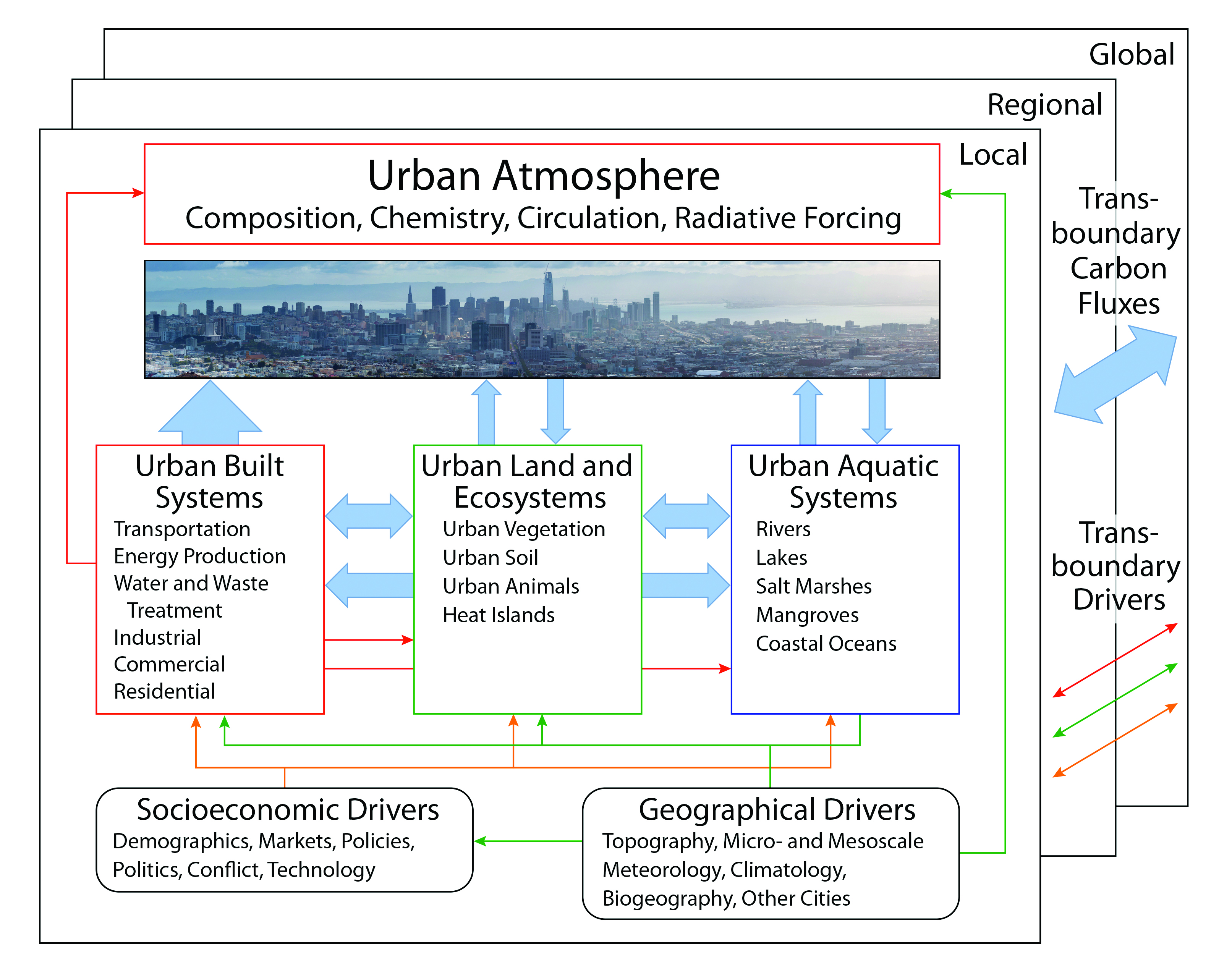<b>Gurney</b>, K. R., P. <b>Romero-Lankao</b>, S. <b>Pincetl</b>, M. Betsill, M. Chester, F. Creutzig, K. Davis, R. Duren, G. Franco, S. Hughes, L. R. Hutyra, C. Kennedy, R. Krueger, P. J. Marcotullio, D. Pataki, D. Sailor, and K. V. R. Schäfer, 2018: Chapter 4: Understanding urban carbon fluxes. In Second State of the Carbon Cycle Report (SOCCR2): A Sustained Assessment Report [Cavallaro, N., G. Shrestha, R. Birdsey, M. A. Mayes, R. G. Najjar, S. C. Reed, P. Romero-Lankao, and Z. Zhu (eds.)]. U.S. Global Change Research Program, Washington, DC, USA, pp. 189-228, https://doi.org/10.7930/SOCCR2.2018.Ch4.
Understanding Urban Carbon Fluxes
Urban areas are concentrated domains of carbon fluxes because of the sheer magnitude of 1) urban populations; 2) economic activities; and 3) the fossil fuel–based energy, goods, and services on which these areas currently depend. Though sensitive to the urban boundary definition chosen and the accounting framework adopted (production versus consumption), carbon fluxes resulting from urban activities are estimated to be responsible for up to 80% of the total North American anthropogenic flux of carbon dioxide (CO2) to the atmosphere (Jones and Kammen 2014; Seto et al., 2014). Per capita energy consumption in U.S. urban areas is estimated to be 13% to 16% less than the national average, and consumption varies more widely across cities than in rural areas (Parshall et al., 2010; see Figure 4.1). This concentrated source of carbon emissions is dominated by the combustion of fossil fuels (see Ch. 3: Energy Systems for a detailed treatment of carbon emissions associated with energy systems). However, other direct fluxes include carbon exchanged by the urban biosphere, methane (CH4) emissions from leaking infrastructure, anaerobic decomposition (e.g., landfills and wastewater treatment), and human respiration. Cities are also responsible for large indirect fluxes via the demand for goods and services that are produced elsewhere. Understanding urban carbon fluxes is essential to understanding the spatiotemporal distribution of global anthropogenic carbon flux, the forces driving fossil fuel–based consumption, and the policy options available to cities in their role as innovators in emissions mitigation. This chapter aims to assess this understanding.
Figure 4.1: Per Capita Energy Consumption Versus Total Energy Consumption in Rural to Urban U.S. Counties
The current understanding of carbon fluxes from urban areas has improved considerably since the First State of the Carbon Cycle Report (SOCCR1; CCSP 2007). Numerous urban carbon flux studies have been completed, and long-term research aimed at understanding aspects of urban carbon flows, drivers, and policy dimensions continues in some cities. Though often challenging to integrate, the growing number of studies within the North American urban domain are helping to improve understanding and establish new scientific knowledge and application to policymaking (Chester et al., 2014; Gurney et al., 2015; Hutyra et al., 2014; Marcotullio et al., 2014; Romero-Lankao et al., 2014).
Carbon flux differences within and across urban areas are more complex than the sum of populations, reflecting complex relationships among consumption, technology, infrastructure, economics, and behavior and lifestyle (see Figure 4.2; Lenzen and Peters 2009; Lenzen et al., 2008; Seto et al., 2014). A key component of urban carbon emissions, and a driver of future trends, is the interaction between human activity and the built environment, which includes large infrastructural systems such as buildings, roads, and factories. One need is to explore how urban infrastructure and morphology will influence current and future energy consumption and development (Creutzig et al., 2016; Müller et al., 2013; Salat and Bourdic 2012; Schiller 2007; Tanikawa and Hashimoto 2009).
Figure 4.2: Key Components of Urban Carbon Cycling

The emerging role of subnational and transnational organizations and stakeholders within international policymaking, combined with the dominance of urban carbon emissions, has brought mitigation of carbon emissions from cities into consideration (Hsu et al., 2015; Rosenzweig et al., 2010, 2016; Wang 2012). Carbon mitigation approaches in North American cities vary widely due to a number of factors such as the urban economic profile, local policy initiatives, climate, and interactions with other governance levels (Homsy and Warner 2014; Krause 2012; Markolf et al., 2017; Sharp et al., 2010; Zahran et al., 2008). The impact of local policies on carbon emissions often is not monitored or assessed (Bulkeley 2010; Portney 2013), nor are the drivers for carbon mitigation policies systematically understood. Thus, causal links between policy and atmospheric effects are not always well known and may be unique to the city (Hughes 2017). Critically, urban emissions mitigation opportunities are often dependent upon or limited by interaction with governance at county, state, or provincial scales, emphasizing a need to better understand these relationships within the context of climate policy. For a better understanding of the societal drivers, further research is necessary on the interrelated environmental costs, benefits, constraints, and opportunities of different approaches within North American cities.
See Full Chapter & References
